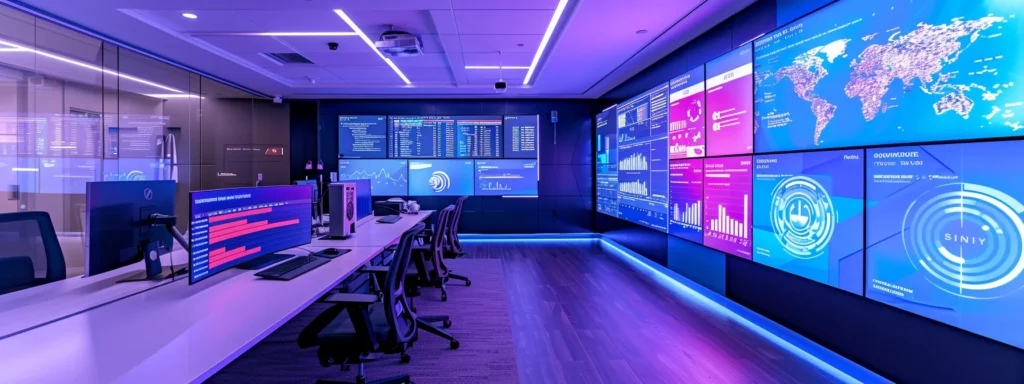Best Practices for Effective Website Security Protocols
Is your website truly safe from cyber threats? In today’s digital landscape, robust security protocols are essential for protecting your online presence. This article outlines key practices for fortifying your website’s defenses, including secure coding habits, rigorous access control, and regular vulnerability scans. By implementing these strategies, you’ll safeguard your site’s data, maintain customer trust, and prevent costly security breaches. Learn how to create a comprehensive security plan that keeps your website protected against evolving online threats.
Fortify Your Website's Defenses With Essential Protocols

Effective website security protocols and website security maintenance are essential for protecting against vulnerabilities and unauthorized access. This section explores crucial measures including implementing HTTPS for encrypted connections, deploying web application firewalls, selecting secure hosting providers, configuring security headers, and mitigating DDoS attacks. These strategies help fortify websites against common internet threats, ensuring robust password and access control measures.
Implement HTTPS Everywhere for Encrypted Connections
HTTPS implementation is a critical step in fortifying website defenses. By encrypting all data transmitted between users and the website, HTTPS protects sensitive information from interception and tampering. This protocol is especially important for sites handling personal data, financial transactions, or login credentials.
To implement HTTPS effectively, website owners should obtain an SSL/TLS certificate from a reputable provider and configure their web server to use it. Regular audits of the content management system and application firewall settings help ensure ongoing protection. Additionally, using a virtual private network can add an extra layer of security for remote access to website administration tools:
| Security Measure | Purpose | Implementation |
|---|---|---|
| HTTPS | Encrypt data transmission | SSL/TLS certificate |
| Web Application Firewall | Filter malicious traffic | Server configuration |
| Content Management System Audit | Identify vulnerabilities | Regular security checks |
| Virtual Private Network | Secure remote access | VPN service setup |
Deploy a Web Application Firewall to Filter Malicious Traffic
Web Application Firewalls (WAFs) serve as a crucial defense mechanism against malicious traffic. These software systems filter incoming requests, blocking potential threats before they reach the website. WAFs protect against common attacks like SQL injection, cross-site scripting, and DDoS attempts, enhancing overall website security.
Implementing a WAF involves selecting a reputable provider and configuring the software to match specific security needs. Many content delivery networks offer integrated WAF solutions, simplifying deployment. Regular updates and monitoring ensure the WAF remains effective against evolving threats, complementing antivirus software in protecting against malware:
| WAF Feature | Benefit | Implementation |
|---|---|---|
| Traffic Filtering | Blocks malicious requests | Rule-based configuration |
| DDoS Protection | Mitigates attack attempts | Traffic analysis and rate limiting |
| Integrated CDN | Improves performance and security | CDN provider selection |
| Regular Updates | Maintains protection against new threats | Automated or scheduled updates |
Select a Secure Hosting Provider With Strong Infrastructure
Selecting a secure hosting provider with robust infrastructure forms the foundation of effective website security. A reputable host employs advanced transport layer security protocols, protecting against cyberattacks and sql injection attempts. These providers maintain up-to-date servers, firewalls, and intrusion detection systems to safeguard websites from evolving threats.
When choosing a hosting service, website owners should prioritize providers offering comprehensive internet security measures. This includes regular security audits, data encryption, and automated backups to ensure information security. A reliable host also provides 24/7 monitoring and support, quickly addressing potential vulnerabilities and minimizing downtime in case of security incidents.
Configure Security Headers for Added Browser Protection
Configuring security headers is a crucial step in web development to enhance browser protection against common vulnerabilities. By implementing headers such as Content-Security-Policy, X-Frame-Options, and Strict-Transport-Security, web servers can instruct browsers to enforce additional security measures. These headers help prevent attacks like cross-site scripting, clickjacking, and protocol downgrade attempts.
Website owners should work with their web design team to properly set up and test security headers. Regular security audits and patching of the web server software are essential to maintain effective protection. Implementing these headers, along with other security measures, helps create a robust defense against phishing attempts and other online threats.
Mitigate Distributed Denial of Service Attacks
Mitigating Distributed Denial of Service (DDoS) attacks requires a multi-layered approach involving firewalls, web browser protections, and domain name system safeguards. Organizations should implement robust security information and event management systems to detect and respond to potential DDoS threats quickly, preventing data breaches and service disruptions.
Effective DDoS mitigation strategies include traffic analysis, rate limiting, and the use of content delivery networks to absorb and filter malicious traffic. Website owners should work with their hosting providers to ensure adequate bandwidth and server resources are available to handle traffic spikes, while regularly updating and patching all systems to address vulnerabilities that could be exploited in DDoS attacks.
Adopt Secure Coding and Software Management Habits

Secure coding and software management practices are crucial for minimizing attack surfaces and preventing ransomware threats. This section explores guidelines for preventing common flaws, updating content management systems, sanitizing user inputs, managing third-party scripts, and using version control. These strategies help protect websites from vulnerabilities, ensuring robust security in cloud computing environments and regular backups.
Follow Secure Coding Guidelines to Prevent Common Flaws
Secure coding practices are essential for preventing common vulnerabilities in WordPress, SQL databases, and server-side applications. Developers should follow industry-standard guidelines to mitigate risks such as SQL injection, cross-site scripting, and buffer overflows. These practices include input validation, parameterized queries, and proper error handling to protect sensitive data and maintain regulatory compliance.
Regular code reviews and automated security testing help identify potential flaws before they can be exploited. Developers should stay informed about the latest security threats and update their coding practices accordingly. Implementing secure coding habits across all aspects of web development, from front-end interfaces to back-end databases, creates a robust defense against cyber attacks:
- Validate and sanitize all user inputs
- Use prepared statements for database queries
- Implement proper authentication and authorization mechanisms
- Encrypt sensitive data at rest and in transit
- Regularly update and patch all software components
Regularly Update Your CMS Plugins and Themes
Regular updates of Content Management System (CMS) plugins and themes are crucial for maintaining robust web application security. These updates often include patches for vulnerabilities that could be exploited by malicious actors to gain unauthorized access or compromise sensitive data, including credit card information. Website administrators should establish a routine update schedule to ensure all components remain current and protected against known threats.
Implementing automatic updates for CMS components can significantly enhance a website’s security posture. This practice not only protects against potential exploits but also improves search engine optimization by demonstrating active maintenance. Website owners should regularly audit their plugins and themes, removing any unused or outdated components to reduce the attack surface and streamline authentication processes.
Sanitize All User Inputs to Stop Injection Attacks
Sanitizing user inputs is crucial for preventing injection attacks, which can exploit vulnerabilities in internet information services and artificial intelligence systems. Developers must implement rigorous input validation and sanitization techniques to protect against SQL injection, cross-site scripting, and other forms of malicious input. This process involves filtering and encoding user-supplied data before it interacts with the application’s backend or database.
Effective input sanitization policies should be integrated into the development lifecycle, considering the diverse range of devices in the Internet of Things ecosystem. By systematically cleansing and validating all user inputs, organizations can significantly reduce the risk of exploits targeting web applications, APIs, and connected devices. Regular security audits and penetration testing help ensure these sanitization measures remain effective against evolving threats:
- Implement input validation at both client and server sides
- Use parameterized queries to prevent SQL injection
- Encode output to prevent cross-site scripting attacks
- Regularly update sanitization libraries and techniques
- Conduct security audits to identify potential vulnerabilities
Manage Third Party Scripts and Libraries Carefully
Managing third-party scripts and libraries requires careful consideration to prevent credential stuffing attacks and maintain robust cybersecurity. Website administrators must evaluate the security implications of external code, ensuring it aligns with their organization’s technology standards and TLS protocols. Regular audits of third-party components help identify potential vulnerabilities and enable timely updates or replacements.
To enhance security, website owners should implement content security policies that restrict the execution of unauthorized scripts. This approach helps mitigate risks associated with compromised third-party resources. Additionally, using subresource integrity checks can verify the integrity of external scripts, further protecting against supply chain attacks:
| Security Measure | Purpose | Implementation |
|---|---|---|
| Content Security Policy | Restrict unauthorized scripts | HTTP header configuration |
| Subresource Integrity | Verify script integrity | Hash-based validation |
| Regular Audits | Identify vulnerabilities | Automated scanning tools |
| Vendor Assessment | Evaluate third-party security | Security questionnaires |
Use Version Control for Secure Code Management
Version control systems play a crucial role in secure code management for website security. By tracking changes, managing collaborations, and enabling rollbacks, version control tools like Git help developers maintain a secure and organized codebase. This practice is essential for implementing a comprehensive website security checklist and ensuring the integrity of the domain’s source code.
Implementing version control as part of a robust WAF strategy enhances overall website security. It allows teams to review code changes, identify potential vulnerabilities, and maintain a clear audit trail of modifications. Version control systems also facilitate secure collaboration among developers, reducing the risk of unauthorized code alterations:
| Version Control Feature | Security Benefit | Implementation |
|---|---|---|
| Change Tracking | Audit trail for code modifications | Commit logs and diffs |
| Branching | Isolated development environments | Feature branches |
| Code Review | Peer assessment of security implications | Pull requests |
| Rollback Capability | Quick recovery from security issues | Revert commits |
Control Access and Authenticate Users Rigorously

Effective access control and user authentication are crucial components of web application security. This section explores implementing strong password policies and multi-factor authentication, applying the principle of least privilege, securing administrative access points, monitoring user activity logs, and managing API keys securely. These practices form the foundation of a robust cyber security strategy, aligning with OWASP top recommendations and enhancing overall website design security.
Enforce Strong Password Policies and Multi Factor Authentication
Enforcing strong password policies and multi-factor authentication are critical practices for securing business websites and mobile apps. Website owners should implement strict password requirements, including minimum length, complexity, and regular expiration periods. Additionally, enabling HTTP Strict Transport Security (HSTS) helps protect against password interception attacks by ensuring secure connections.
Multi-factor authentication adds an extra layer of security to the domain name system and user accounts. By requiring a second form of verification, such as a mobile app code or biometric scan, websites significantly reduce the risk of unauthorized access even if passwords are compromised. This approach aligns with industry best practices and strengthens overall cybersecurity posture.
Apply the Principle of Least Privilege for User Roles
Applying the principle of least privilege is crucial for protecting personal data and minimizing vulnerabilities in website security. This approach restricts user access rights to the minimum permissions necessary for their role, reducing the potential impact of compromised credentials. By implementing granular access controls, organizations can better safeguard sensitive information and limit the exposure of critical systems to potential threats.
Website administrators should regularly audit user roles and permissions, ensuring that access levels align with current job responsibilities. This practice extends to JavaScript permissions and marketing tools, where unnecessary access can lead to security risks. Implementing a vulnerability scanner can help identify overprovisioned accounts and potential security gaps. The principle of least privilege should be applied across all aspects of website management, including:
- User account management
- Database access controls
- Content management system roles
- API permissions
- Server and hosting environment access
Secure Administrative Access Points Diligently
Securing administrative access points is crucial for maintaining robust website security. Organizations should implement stringent access controls for administrative interfaces, aligning with OWASP guidelines and industry best practices. This includes using strong, unique passwords, multi-factor authentication, and IP whitelisting to restrict access to trusted networks.
Regular security audits of administrative infrastructure help identify vulnerabilities in content management systems and software development environments. Organizations should implement secure protocols for remote access, such as VPNs, and regularly update administrative tools to patch known security flaws. Effective management of administrative access points is essential for protecting sensitive data and maintaining the integrity of content marketing efforts:
| Security Measure | Purpose | Implementation |
|---|---|---|
| Multi-Factor Authentication | Enhance login security | Require additional verification |
| IP Whitelisting | Restrict access to trusted networks | Configure firewall rules |
| VPN for Remote Access | Secure off-site connections | Implement encrypted tunnels |
| Regular Security Audits | Identify vulnerabilities | Conduct penetration testing |
Monitor User Activity Logs for Suspicious Behavior
Monitoring user activity logs is crucial for detecting suspicious behavior and potential cybercrime in computer networks. Organizations should implement robust logging systems that track customer interactions, login attempts, and data access patterns. By analyzing these logs, security teams can identify anomalies that may indicate social engineering attacks or unauthorized access attempts.
Effective log monitoring requires advanced tools and expertise to sift through large volumes of data. Cloud-based security services like Cloudflare offer powerful analytics capabilities to help detect and respond to threats quickly. Regular review of activity logs enables organizations to spot potential security breaches early, allowing for prompt intervention and mitigation of risks to the network and customer data.
Manage API Keys and Application Secrets Securely
Secure management of API keys and application secrets is crucial for protecting sensitive data and preventing unauthorized access. Organizations should implement robust logging systems to track API usage and detect potential spamming attempts. Utilizing specialized tools for secret management helps encrypt and safeguard these credentials, especially important for teams engaged in remote work.
Best practices include rotating API keys regularly, using environment variables to store secrets, and implementing strict access controls. Organizations should consider adopting a secure PDF-based documentation system for sharing sensitive information among team members. This approach enhances security while maintaining accessibility for authorized personnel working remotely.
Perform Consistent Security Checks and Vulnerability Scans

Regular security checks and vulnerability scans are essential for maintaining robust website security protocols. This section explores automated scanning routines, expert penetration testing, log analysis, threat intelligence, and security audits. These practices help identify vulnerabilities, detect anomalies, and mitigate risks across web and mobile platforms. By implementing comprehensive risk management strategies, organizations can enhance their API security and protect against evolving cyber threats.
Schedule Automated Vulnerability Scanning Routines
Scheduling automated vulnerability scanning routines is essential for maintaining robust website security. These scans utilize advanced algorithms to detect potential vulnerabilities in web applications, cloud infrastructure, and information systems. By regularly assessing the security posture, organizations can identify and address weaknesses before they can be exploited by malicious actors.
Effective vulnerability scanning includes comprehensive checks of login mechanisms, database connections, and programming language implementations. Cloud-based scanning solutions offer scalable and efficient options for organizations of all sizes. Implementing a regular scanning schedule, such as weekly or bi-weekly scans, ensures that new vulnerabilities are quickly identified and addressed:
| Scan Type | Frequency | Target Areas |
|---|---|---|
| Network Vulnerability Scan | Weekly | Servers, Firewalls, Routers |
| Web Application Scan | Bi-weekly | Web Pages, APIs, Forms |
| Database Security Scan | Monthly | Database Servers, Access Controls |
| Cloud Infrastructure Scan | Weekly | Cloud Services, Storage, Networking |
Conduct Periodic Penetration Testing With Experts
Periodic penetration testing conducted by experts is crucial for identifying vulnerabilities in website security that automated scans may miss. These tests simulate real-world attacks, probing for weaknesses in password policies, security tokens, and overall website architecture. By engaging skilled professionals, organizations can gain valuable insights into their security posture and prioritize improvements.
Expert penetration testers employ advanced techniques to assess website security, including fingerprinting methods to identify potential attack vectors. They evaluate the effectiveness of existing security measures, such as password policies and token-based authentication systems. This hands-on approach to security assessment provides a comprehensive learning experience for organizations, helping them strengthen their defenses against evolving cyber threats.
Review Server and Application Logs Frequently for Anomalies
Regular review of server and application logs is essential for maintaining website security and ensuring confidentiality. By analyzing these logs, organizations can detect anomalies that may indicate potential security breaches or unauthorized access attempts. This practice forms a crucial part of any comprehensive security checklist, enabling proactive identification of threats before they escalate.
Advanced machine learning algorithms can enhance log analysis, automatically flagging suspicious patterns and potential security risks. This approach streamlines the review process, allowing security teams to focus on high-priority issues and refine their website design to address vulnerabilities. Implementing a robust log review strategy helps organizations stay ahead of evolving cyber threats and maintain a strong security posture.
Stay Informed About New Security Threats and Patches
Staying informed about new security threats and patches is crucial for maintaining robust website security protocols. Organizations should establish a systematic approach to monitoring security bulletins, industry reports, and vendor notifications. This proactive stance enables quick identification and response to emerging vulnerabilities, ensuring timely application of critical patches and updates.
Implementing a dedicated security information and event management (SIEM) system can streamline the process of tracking and analyzing security threats. These tools aggregate data from various sources, providing real-time insights into potential risks and recommended mitigation strategies. Regular team briefings and security awareness training sessions help ensure all staff members are informed about the latest threats and best practices for maintaining website security:
- Subscribe to reputable security newsletters and forums
- Participate in industry-specific threat intelligence sharing platforms
- Utilize automated patch management systems for timely updates
- Conduct regular security audits to identify potential vulnerabilities
- Establish a response plan for addressing newly discovered threats
How Security Audits Improve Website Security Protocols
Security audits play a crucial role in improving website security protocols by systematically evaluating and identifying vulnerabilities in an organization’s digital infrastructure. These comprehensive assessments examine various aspects of website security, including network configurations, access controls, and data protection measures. By conducting regular audits, businesses can proactively address potential weaknesses before they can be exploited by malicious actors.
The insights gained from security audits enable organizations to refine their security strategies and implement more robust protocols. Auditors often provide detailed reports highlighting specific areas for improvement, along with recommendations for enhancing overall security posture. This process helps businesses stay ahead of evolving cyber threats, ensuring their websites remain resilient against potential attacks and compliant with industry standards.
Prepare for Security Incidents With Proactive Monitoring

Proactive monitoring is essential for effective website security. This section explores setting up real-time security monitoring systems, developing incident response strategies, defining roles for security events, practicing response drills, and communicating breaches transparently. These practices help organizations detect and respond to threats quickly, minimizing potential damage and maintaining trust with users.
Set Up Real Time Security Monitoring Systems
Real-time security monitoring systems are essential for detecting and responding to potential threats promptly. These systems continuously analyze network traffic, log files, and user activities to identify suspicious patterns or anomalies that may indicate a security breach. By implementing advanced monitoring tools, organizations can significantly reduce the time between an attack’s initiation and its detection, minimizing potential damage.
Effective real-time monitoring requires a combination of automated tools and human expertise. Organizations should invest in security information and event management (SIEM) solutions that aggregate data from multiple sources, providing a comprehensive view of their security landscape. Regular training for security personnel ensures they can interpret alerts accurately and respond swiftly to potential threats, enhancing the overall effectiveness of the monitoring system.
Develop a Clear Website Incident Response Strategy
Developing a clear website incident response strategy is crucial for effectively managing security breaches. Organizations should create a comprehensive plan that outlines specific steps to be taken when a security incident occurs, including roles and responsibilities, communication protocols, and containment procedures. This strategy ensures a swift and coordinated response, minimizing potential damage and downtime.
Regular testing and updates of the incident response plan are essential to maintain its effectiveness. Organizations should conduct simulated security breaches to evaluate their team’s readiness and identify areas for improvement. By continuously refining their response strategy, businesses can stay prepared for evolving cyber threats and protect their digital assets more effectively.
Define Roles and Responsibilities for Security Events
Defining clear roles and responsibilities for security events is crucial for effective incident response. Organizations should establish a dedicated security team with specific assignments for each member, including incident detection, analysis, containment, and recovery. This structure ensures a coordinated and efficient response to potential threats, minimizing confusion and delays during critical moments.
Regular training and simulations help team members understand their roles and responsibilities in various security scenarios. By conducting periodic drills, organizations can identify gaps in their response strategy and refine their processes. This proactive approach enhances the team’s readiness to handle real security incidents, improving overall website protection and reducing potential downtime.
Practice Incident Response Drills Periodically
Practicing incident response drills periodically is crucial for maintaining an effective website security protocol. These drills simulate real-world security threats, allowing teams to test their readiness and refine their response strategies. By regularly conducting these exercises, organizations can identify gaps in their incident response plans and improve their ability to handle actual security breaches efficiently.
Effective incident response drills should involve all relevant team members and cover various scenarios, from data breaches to DDoS attacks. Organizations should document the outcomes of each drill, analyzing response times, decision-making processes, and communication effectiveness. This approach enables continuous improvement of the incident response strategy, ensuring the team remains prepared for evolving cyber threats:
- Define realistic scenarios based on current threat landscapes
- Assign specific roles and responsibilities to team members
- Set clear objectives and success criteria for each drill
- Conduct post-drill debriefings to identify areas for improvement
- Update incident response plans based on drill outcomes
Communicate Security Breaches Transparently and Promptly
Transparent and prompt communication of security breaches is crucial for maintaining trust and compliance. Organizations should establish clear protocols for notifying affected parties, including customers, partners, and regulatory bodies, as soon as a breach is detected and verified. This proactive approach demonstrates accountability and helps mitigate potential reputational damage.
Effective breach communication involves providing accurate information about the nature of the incident, its potential impact, and steps being taken to address the issue. Organizations should offer guidance on protective measures affected individuals can take and provide regular updates as the situation evolves. By prioritizing transparency and timeliness in breach communications, businesses can foster trust and demonstrate their commitment to data protection.
Safeguard Website Data With Encryption and Secure Backups

Safeguarding website data is crucial for maintaining security and user trust. This section explores essential practices for protecting sensitive information, including data encryption, secure backup procedures, regular restoration testing, compliance with privacy regulations, and proper disposal of outdated data and hardware. By implementing these measures, organizations can significantly enhance their website security protocols and protect against potential data breaches.
Encrypt Sensitive Data Both at Rest and in Transit
Encrypting sensitive data both at rest and in transit is a critical component of robust website security protocols. Organizations should implement strong encryption algorithms to protect information stored in databases and servers, as well as data transmitted between users and the website. This approach safeguards against unauthorized access and data breaches, ensuring the confidentiality and integrity of sensitive information.
Effective encryption strategies involve using industry-standard protocols such as TLS for data in transit and AES for data at rest. Website owners should regularly audit their encryption practices to ensure they remain up-to-date with evolving security standards. Implementing proper key management and access controls further enhances the effectiveness of encryption measures:
- Use HTTPS for all web traffic
- Encrypt databases and file systems
- Implement secure key management practices
- Regularly update encryption algorithms
- Conduct periodic encryption audits
Implement Automated and Secure Backup Procedures
Implementing automated and secure backup procedures is crucial for safeguarding website data against potential loss or corruption. Organizations should establish regular, automated backup schedules that capture all critical data, including databases, user files, and system configurations. These backups should be encrypted and stored in secure, off-site locations to protect against physical threats and ensure data availability in case of on-site disasters.
To enhance the security of backup procedures, organizations should implement multi-factor authentication for accessing backup systems and regularly audit access logs. It’s essential to test backup integrity and restoration processes periodically to ensure data can be recovered quickly and completely in the event of a security incident. Best practices for secure backup procedures include:
- Use encryption for backup data both in transit and at rest
- Store backups in geographically diverse locations
- Implement version control for backups to allow point-in-time recovery
- Regularly test backup restoration processes
- Maintain detailed documentation of backup and recovery procedures
Test Your Backup Restoration Process Regularly
Regular testing of backup restoration processes is crucial for ensuring data recovery capabilities in the event of a security incident or system failure. Organizations should establish a routine schedule for performing full restoration tests, verifying the integrity and completeness of backed-up data. These tests help identify potential issues in the backup process and ensure that critical information can be recovered quickly and accurately when needed.
Effective backup restoration testing involves simulating various scenarios, such as partial data loss, complete system failures, or ransomware attacks. By conducting these tests, organizations can refine their recovery procedures, identify bottlenecks, and estimate realistic recovery time objectives. This proactive approach significantly enhances website security protocols and business continuity planning:
- Schedule quarterly full restoration tests
- Simulate different data loss scenarios
- Document and analyze restoration performance
- Update recovery procedures based on test results
- Train IT staff on restoration processes
Comply With Data Privacy Regulations Applicable to Your Users
Complying with data privacy regulations applicable to users is essential for maintaining website security and trust. Organizations must identify and adhere to relevant laws such as GDPR, CCPA, or industry-specific regulations that govern the collection, storage, and processing of user data. Implementing robust data protection measures, including encryption and access controls, helps ensure compliance and protects sensitive information from unauthorized access.
Regular audits of data handling practices are crucial for maintaining compliance with evolving privacy regulations. Organizations should establish clear policies for data collection, usage, and retention, ensuring transparency with users about how their information is managed. Providing users with options to control their data, such as consent management and data deletion requests, further enhances compliance efforts and builds trust in the website’s security protocols.
Securely Dispose of Outdated Data and Retired Hardware
Secure disposal of outdated data and retired hardware is crucial for maintaining robust website security protocols. Organizations should implement comprehensive data destruction policies that include secure deletion methods for digital files and physical destruction of storage devices. This process helps prevent unauthorized access to sensitive information and reduces the risk of data breaches from discarded equipment.
When retiring hardware, organizations should use certified data destruction services to ensure complete erasure of stored information. This includes degaussing magnetic media, shredding solid-state drives, and obtaining certificates of destruction for compliance purposes. Proper disposal practices not only protect sensitive data but also demonstrate a commitment to user privacy and regulatory compliance.
Frequently Asked Questions
How can I implement essential security protocols for my website?
Implement HTTPS encryption, use strong passwords, keep software updated, employ a firewall, and regularly back up data. Enable two-factor authentication, install security plugins, and conduct routine vulnerability scans. Educate users on security best practices and monitor website activity for suspicious behavior.
What are the best practices for secure coding and software management?
Secure coding practices include input validation, proper error handling, and encryption of sensitive data. Software management best practices involve version control, regular security audits, and implementing least privilege access. Developers should also stay updated on security vulnerabilities and use secure coding frameworks to mitigate risks.
How do I strengthen user authentication and access control?
To strengthen user authentication and access control, implement multi-factor authentication, use strong password policies, enforce regular password changes, encrypt sensitive data, limit login attempts, employ role-based access control, and regularly audit user privileges. Additionally, consider using biometric authentication methods and implementing single sign-on solutions for enhanced security.
How often should I perform security checks and vulnerability scans?
Regular security checks and vulnerability scans should be performed at least quarterly, with more frequent scans for critical systems or after significant changes. Monthly scans are ideal for most businesses to stay ahead of emerging threats and maintain a strong security posture.
What steps should I take to prepare for potential security incidents?
To prepare for potential security incidents, develop an incident response plan, conduct regular risk assessments, implement strong access controls, train employees on security protocols, backup data frequently, and keep software updated. Establish communication procedures and designate response team roles to ensure swift action during emergencies.
Conclusion
Implementing robust website security protocols is crucial for protecting sensitive data, maintaining user trust, and safeguarding against evolving cyber threats. By adopting best practices such as encryption, secure coding, regular vulnerability scans, and proactive monitoring, organizations can significantly reduce their risk of data breaches and unauthorized access. Effective incident response strategies, coupled with transparent communication and compliance with data privacy regulations, further enhance an organization’s security posture and demonstrate commitment to user protection. Ultimately, prioritizing website security through comprehensive protocols and continuous improvement is essential for maintaining a strong online presence and ensuring long-term business success in today’s digital landscape.






